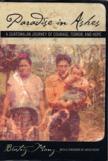Guatemala Nunca Ms!
What paradise and what ashes are meant by the title Paradise in Ashes: A Guatemalan Journey of Courage, Terror, and Hope? The paradise refers to the small village of Santa María Tzejá. In the late 1960’s, it was virtually carved out of the rain forest in northern Guatemala by a group of poor, indigenous people no longer able to scratch out a living in the soil-depleted highlands. They were led in their arduous journey to the rain forest by a Spanish-born priest, Father Luís, who both promoted the move and organized a cooperative that helped to create a near-model community. One private U.S. aid organization provided cattle. Another donated a small plane with an American pilot to offset the village’s isolated location. Thus, by the early 1970’s the creation of this humble paradise had begun.
But the paradise lasted only a few years before being leveled to ashes by the Guatemalan military. Believing Santa María Tzejá and surrounding settlements to be aiding insurgents, the army swept through with a devastating force marked by atrocities. “The demonic manner in which people were butchered and the highly visible ways in which the cadavers were left...was meant to scar the living,” the author, Beatriz Manz, tells us in this remarkable book. She goes on to describe how those not massacred in the village fled into the jungle, where many were hunted down and slaughtered. A professor of geography and ethnic studies at the University of California, Berkeley, the Chilean-born Professor Manz first visited the village as a graduate student in anthropology soon after the arrival of its first settlers. Over a period of 30 years she returned again and again, witnessing both the paradise and the ashes—and the finally reconstructed village once the peace accords were signed.
Both collectively and individually, Manz served as a source of support for the indigenous—largely Mayan—inhabitants. She also provided first-person accounts of human rights abuses to groups like Amnesty International that used her information to prepare reports on the genocide taking place. These reports were largely ignored by the U.S. government, which continued to supply arms to the military along with training for its commanders. “The Reagan administration’s thinking,” she writes, “was that while the Guatemalan military might be doing unsavory things, they were nevertheless an ally in a larger geopolitical struggle—the cold war.”
Aware that the military viewed her with suspicion, Manz went so far as to write her field notes, some of which became the basis for the book, in code. To confront rumors that she was in league with the guerillas, she boldly visited the nearby army base to confront the commander, who, at least on the surface, accepted her assertion that her work was undertaken for anthropological research. The danger was very real. Accompanying her on that visit, though not part of it, was Myrna Mack, a close friend and fellow anthropologist, who was subsequently stabbed to death by a government agent in Guatemala City. The same fate might easily have overtaken Manz. Her presence throughout the book as a participant in much of what was taking place imbues the book with a moving autobiographical tone.
So horrific had the terror become by 1980, with Catholic clergy and lay catechists being targeted along with civilians, that Bishop Juan Gerardi closed all the dioceses of the Province of El Quiché. Bishop Gerardi was himself murdered just two days after the release of the now-famous 1998 report detailing the army’s human rights violations—Guatemala Nunca Más!—a report for which Gerardi himself was largely responsible, and, hence, which cost him his life.
Father Luís had left long before, aware that he too was living under a virtual death sentence. Evangelical missionaries from the United States who sympathized with the military filled in for the priests, nuns and lay church workers who left, but even they were appalled at the extent of the violence, and “began to question the military’s excesses.”
The close personal relationships Ms. Manz established with many villagers over three decades allowed her to follow the histories of a number of them. Several stand out, like the story of Santos Vicente Sarata, a village carpenter kidnapped by the army, whose remains were never found. His wife, Rosa, fled to a refugee camp in Mexico with their child. Among the few possessions she took with her was a family photograph of herself and Santos, who holds their child in his arms. It is this crinkled photograph of the young family staring directly out at us that the reader sees on the book jacket of Paradise in Ashes—especially moving because of its travel-worn appearance.
Over the years, Manz took photographs of her own, and a number of them appear in the book. They underscore her personal involvement in the life of Santa María Tzejá, and thereby draw the reader all the more fully into this painful yet hope-filled history, based on what was indeed—as the subtitle tells us—“a journey of courage, terror, and hope.” The journey continues into “an uncertain future,” but the hope remains.
This article also appeared in print, under the headline “Guatemala Nunca Ms!,” in the June 6, 2005, issue.








